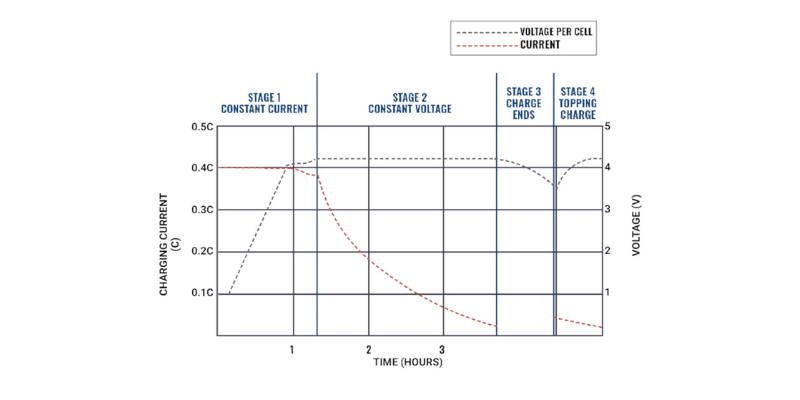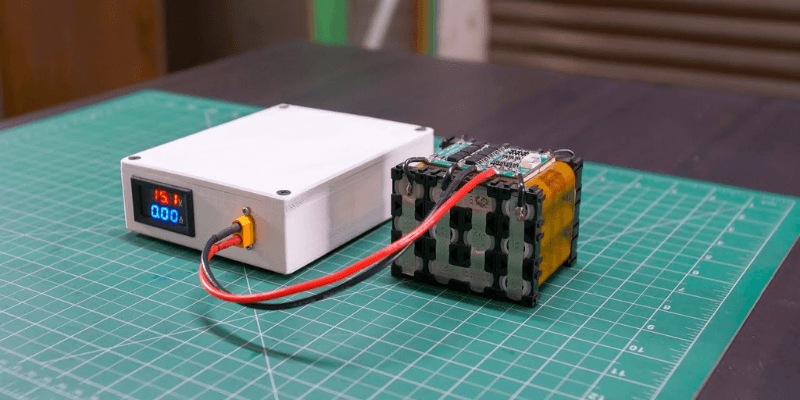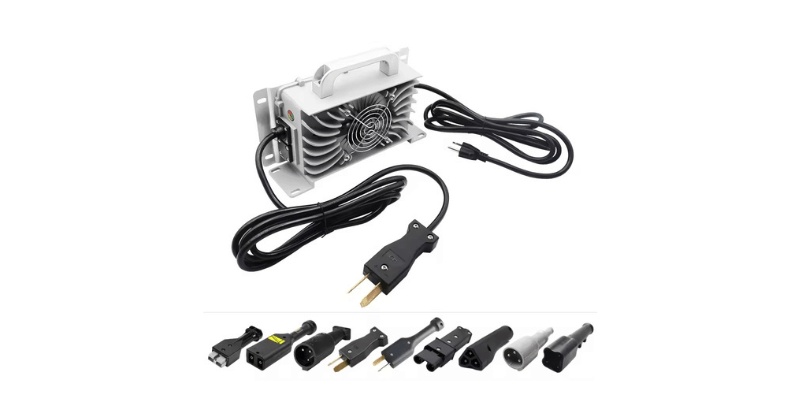Если вы приобрели аккумуляторы с фосфатом литиевого железа (LIFEPO4), вы знаете, что они предлагают больше циклов и являются более легкими, чем запечатанная свинцовая кислота (SLA). Они также заряжаются в четыре раза быстрее, чем батареи SLA. Чтобы зарядить аккумулятор LifePo4, мы рекомендуем использовать Зарядное устройство литиевого батареи Разработано для этой химии.
Может ли свинцовое кислотное зарядное устройство зарядить литиевую батарею?
Этот пост будет освещать сходство в профилях зарядки свинцовых и литийных батарей. Тем не менее, будьте осторожны при использовании свинцовых зарядных устройств для литийных батарей, так как они могут повредить или заряжать их, снижая их емкость с течением времени. Есть значительные различия литий и свинцово -кислотные батареи.
Профиль зарядки зарядки зарядки с запечатанной кислотой (SLA)
Он использует трехэтапный метод для зарядки герметичной свинцовой кислотной батареи: начальный заряд (постоянный ток), заряд насыщения (постоянное напряжение) и заряд плавания.

На стадии 1 ограничьте ток, чтобы предотвратить повреждение батареи. Напряжение поднимается и плато, когда оно приближается к полной зарядке. Этот этап имеет решающее значение и обычно должна выполняться на 10–30% (от 0,1 ° С до 0,3 ° С) емкости аккумулятора.
Стадия 2 начинается, когда напряжение достигает своего предела (14,7 В для быстрого зарядки батарей SLA, 14,4 В для других). Здесь ток уменьшается, пока он не упадет ниже 5% от номинальной емкости.
Этап 3, или платный заряд, поддерживает полную емкость батареи во время резервных применений или хранения, чтобы предотвратить самоуправление и повреждение сульфата на пластины.
Профиль зарядки батареи LifePo4
Батареи LIFEPO4 имеют одинаковые стадии постоянного тока и напряжения, что и батареи SLA, но заряжаются быстрее из -за более высоких показателей заряда.

Зарядка 1-го этапа для батареи LIFEPO4 обычно происходит на 30-100% (от 0,3 ° С до 1,0 ° С) емкости батареи, заполняя примерно через один час по сравнению с четырьмя часами для SLA. Даже при 0,5C батарея LIFEPO4 заряжается почти в три раза быстрее, чем SLA.
Этап 2, необходимый для достижения 100% -ного состояния заряда (SOC), занимает шесть часов для SLA и всего около 15 минут для LifePo4. В целом, литийная батарея может полностью заряжаться через четыре часа, в то время как батарея SLA занимает около десяти часов. В циклическом применении литиевые батареи могут ездить на велосипеде несколько раз в день по сравнению с проведением свинцовых аккумуляторов.
Что касается профилей зарядки на этапе 3, батарея LIFEPO4 не требует плавающей зарядки, такой как свинцовая кислота, и не должна храниться в долгосрочной перспективе. Вместо этого он должен ездить на велосипеде каждые 6-12 месяцев и сохранять только 50% SOC во время хранения.
В резервных приложениях с низкими показателями самоубийца литиевые батареи сохраняют почти полную мощность даже без зарядки в течение года. Для более длительных промежутков рекомендуется заряд начинку на основе напряжения, особенно для батарей с функциями Bluetooth или Wi-Fi.

Характеристики зарядки лития батареи
Настройки напряжения и тока во время зарядки
Полное напряжение открытого заряда (OCV) для батареи SLA 12 В составляет 13,1 В, в то время как он составляет 13,6 В для литийной батареи 12 В. Батарея будет повреждена, только если напряжение зарядки значительно превысит его полное напряжение заряда. Поэтому держите батарею SLA ниже 14,7 В и ниже 15 В для литийных батарей во время зарядки этапа 2. Для зарядки плавания для SLA рекомендуется около 13,8 В.
Для обоих типов существует безопасная зарядка от 13,8 В до 14,7 В, не причиняя повреждения. Зарядные устройства должны соответствовать емкости батареи. Литийные батареи могут заряжаться до 1C, в то время как свинцовая кислота должна оставаться ниже 0,3 ° С. Это означает, что литийная батарея 20AH заряжается до 20А и свинцовую кислоту до 6А.
Ток отсечения заряда устанавливается на 5%, поэтому обе батареи имеют отсечение 0,5А, обычно определяемое настройками зарядного устройства.
Универсальные зарядные устройства часто позволяют выбирать химию, оптимизировать диапазон напряжений и определять, когда батарея полностью заряжена. Они должны автоматически отключаться для литийных батарей или переключаться в режим плавания для батарей SLA.

Литиевые батареи заменяют герметичную свинцовую кислоту в применении плавания
Литиевые батареи часто используются в приложениях, ранее поддерживаемых батареями SLA на плавающем заряде, таких как системы UPS.
Опасения по поводу безопасности возникли, но, как правило, безопасно использовать стандартное зарядное устройство SLA постоянного напряжения для литиевых батарей, если оно соответствует определенным условиям:
- Нет настройки де-сульфатирования
- Быстрое/объемное напряжение заряда 14,7 В
- Рекомендуемое напряжение заряда плавания 13,8 В.
Обратите внимание, что некоторые интеллектуальные или многоэтапные SLA Chargers обнаруживают открытое напряжение цепи (OCV). Если литийная батарея переоборудован и в режиме защиты (около 0V OCV), эти зарядные устройства могут предположить, что батарея мертва и избежать зарядки. Напротив, зарядное устройство с настройкой лития может попытаться восстановить перегруженную батарею.

Долгосрочное хранение
Когда хранение батарей Долгосрочные требования к хранению различаются для SLA и лития батарей.
Во -первых, химия батареи диктует оптимальное состояние заряда (SOC) для хранения. Батареи SLA должны храниться вблизи 100% SOC, чтобы предотвратить сульфатирование, что уменьшает способность из -за накопления кристаллов сульфата. И наоборот, литийные батареи должны храниться примерно на 50% SOC, чтобы поддерживать стабильность в положительном терминале и предотвратить постоянную потерю мощности.
Во-вторых, рассмотрим скорость самостоятельного разряда. Батареи SLA имеют высокий уровень самостоятельного распределения и нуждаются в плавании или зарядке, чтобы оставаться близко к 100% SOC. Литийные батареи имеют более низкую скорость сброса и могут потребовать минимальной зарядки на техническом обслуживании.

Рекомендуемые зарядные устройства аккумулятора
Всегда сопоставляйте ваше зарядное устройство с правильным током и напряжением для батареи. Например, не используйте зарядное устройство 24 В для батареи 12 В.
Используйте зарядное устройство, подходящее для химии вашей батареи, учитывая примечания по использованию SLA зарядного устройства с литиевыми батареями. Убедитесь, что SLA зарядное устройство не имеет режимов дессульфации или зарядки батареи при зарядке литиевых батарей.
Если у вас есть вопросы о совместимости зарядного устройства с Лития аккумуляторных изделий, пожалуйста, напишите нам на помощь.

